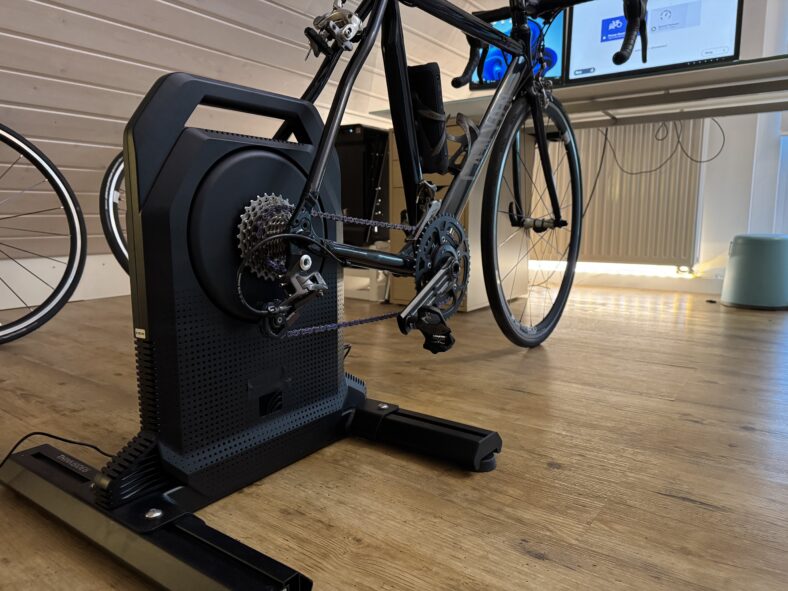Introduction
For several training sessions now, I have been using the ThinkRider XXPro together with MyWhoosh – and it’s genuinely enjoyable. Intervals run smoothly, endurance rides work effortlessly, and most importantly: the noise level is minimal. In this post, I’ll introduce the device in detail – technically, practically, and with my personal assessment.
1. Overview & Positioning
The ThinkRider XXPro is a direct-drive smart trainer with self-power generation. It belongs to the class of “power trainers”, meaning it doesn’t rely solely on magnetic or wind resistance but uses an active motor to generate resistance.
It is therefore suitable for athletes who…
- want to perform more intensive interval training,
- wish to simulate realistic gradients,
- prefer quiet and smooth operation,
- and value compatibility with apps such as MyWhoosh or Zwift.
2. Technical Data & Features
Below is an overview of the key specifications (according to the manufacturer’s manual). Please note: some figures tend to be optimistic – I’ll add my own comments later.
| Feature | Value / Description |
|---|---|
| Resistance System | Electromagnetic / Motor-based (Direct Drive) |
| Max. Power | 2,500 W |
| Max. Simulated Gradient | 25% |
| Power Accuracy | ±1% |
| Connectivity | Bluetooth (BLE), ANT+ / FE-C |
| Dimensions (L × W × H) | approx. 49.5 × 48 × 53 cm |
| Weight | approx. 19.3 kg |
| Compatible Wheel Sizes / Axle Types | Various – e.g. 130/135 QR, 12×142 & 12×148 thru-axle |
| Power Supply / Self-Generation | Generates its own power by pedalling; external supply optionally available |
| Noise Level | Manufacturer’s data: quiet (approx. 56 dB) |
| Compatible Software / Protocols | Supports common apps via ANT+ & BLE (including MyWhoosh, Zwift, etc.) |
Notes on technical values
- The ±1% accuracy claim should be taken with caution – tests of comparable ThinkRider models (e.g. X series) showed occasional deviations.
- The simulated 25% gradient is ambitious; in practice, it’s more likely to feel around 15–20%.
- The noise level is pleasantly low in everyday use, especially compared to older or cheaper devices.
3. Setup & Commissioning
3.1 Packaging & Components
The package usually includes:
- the trainer unit (with fold-out leg mechanism)
- power adapter (if external power supply is used)
- adapters for different axle standards (QR & thru-axle)
- possibly spacers for different cassette sizes
- user manual / quick start guide
- screws for securing / leg attachment
(For more details, see the manual) Manuals++2device.report+2
3.2 Positioning & Alignment
- Place the trainer on a level surface.
- Fold out and lock the support legs.
- Ensure no objects obstruct the cassette or dropout area.
- Mount your bike: remove the rear wheel, install the appropriate adapter, seat the bike securely in the dropout and tighten (QR / thru-axle).
- Connect the power supply if you do not wish to use self-generation mode.
3.3 Calibration & Connectivity
- The manufacturer states that no calibration is required (self-generating + motor-assisted design).
- Firmware updates via app (e.g. ThinkRider Tools).
- Ensure your device (smartphone, tablet, PC) has Bluetooth / ANT+ enabled.
- Connect the trainer in your app/software (MyWhoosh, Zwift, etc.) as a power source (power, cadence, etc.).
- Check if data (power, cadence) are displayed correctly – reconnect if necessary.
4. Practical Experience & Impressions
4.1 Smoothness & Noise
The trainer operates extremely quietly. In an enclosed room and at moderate cadence, only a faint hum can be heard. For many users, it will rank among the quietest trainers in its price range.
4.2 Interval & Endurance Sessions
- Intervals (e.g. 30/30s, threshold rides, etc.) run smoothly and consistently – resistance adjusts quickly.
- Longer endurance rides (e.g. 60–90 mins in base training) remain stable without noticeable fluctuations.
- There’s no lag or overshoot in resistance – at least not within my use cases.
4.3 Gradient & Simulation Feel
- Gradient simulation feels realistic in typical ranges (up to ~15%).
- Extreme gradients (>20%) are noticeable but feel slightly dampened compared to medium slopes.
- The dynamic adjustment when switching between climb and descent works smoothly.
4.4 Accuracy & Measurement Tolerance
- In my comparison rides with known power data (e.g. pedal power meters), deviations were mostly moderate.
- Very short, sharp sprints may show minimal spikes.
- For training and load control, the device is absolutely stable and reliable.
5. Advantages & Limitations
Advantages
- Very quiet operation
- Stable resistance control during interval sessions
- Compatibility with common protocols (Bluetooth, ANT+) and training apps
- Relatively simple setup and configuration
- Self-power generation can be handy (less dependence on mains power)
Limitations / Notes
- Manufacturer’s specifications are optimistic – particularly regarding gradient and accuracy
- In some cases, calibration or app functionality might be limited
- Long-term reliability has not yet been proven over several years (ThinkRider is less established than Wahoo or Tacx)
- Spare parts and support may be harder to obtain
6. Conclusion & Recommendation
The ThinkRider XXPro delivers exactly what I was looking for in practice: a quiet, reliable smart trainer that handles interval work with clean, responsive resistance. The integration with MyWhoosh works flawlessly – performance, connection, and operation are stable.
If you’re looking for a trainer that performs to a high standard, operates quietly, and doesn’t break the bank, the XXPro is a very solid choice. Those demanding absolute top-level accuracy in extreme sprints should ideally pair it with a reference power meter.
Source as of 14 October 2025:
https://s.click.aliexpress.com/e/_c3DUl6rZ 1
- Affiliate-Link, ich bekomme eine kleine Aufwandsentschädigung und Ihr den nach wie vor besten Preis. ↩︎
Additional Infos
3D – STL File:
https://cults3d.com/de/modell-3d/gadget/thinkrider-xxpro-tennis-rocker-plate-easy-riding
3D printed Stands for Tennisballs:
https://www.ebay.de/usr/salu1975


Leave a Reply